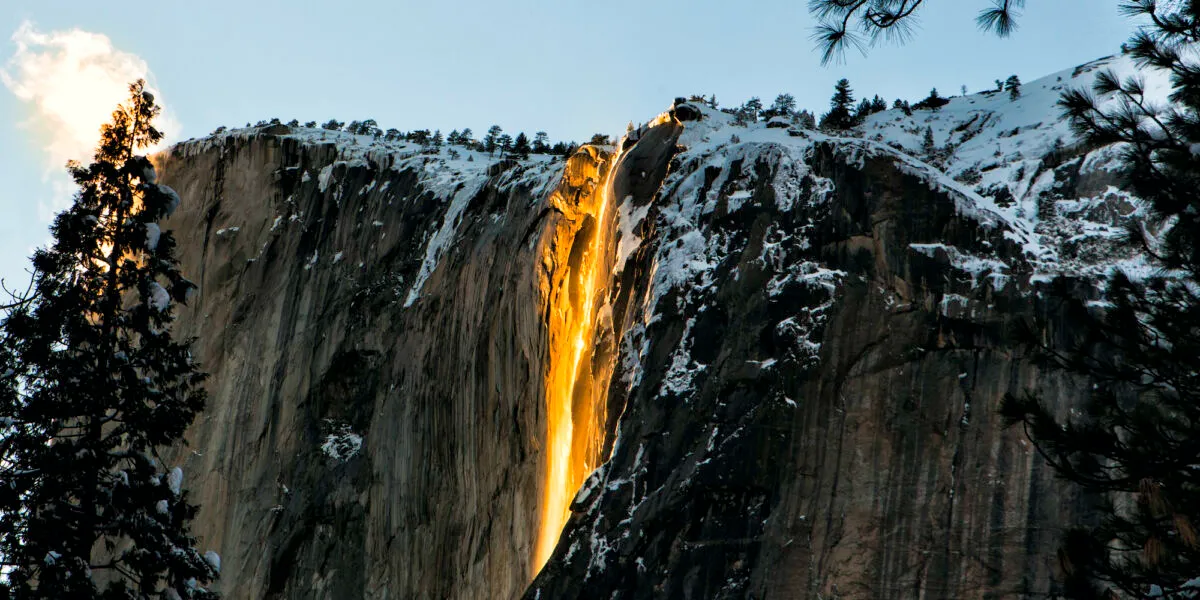Yosemite National Park is home to some of the most stunning waterfalls in the world, making it a must-visit destination for nature lovers and outdoor enthusiasts. From the iconic Yosemite Falls to the lesser-known gems like Wapama Falls, Yosemite offers an array of waterfalls that captivate visitors throughout the year. In this comprehensive guide, the National Park Shops team will take you through the best Yosemite National Park waterfalls, detailing their height, region, flow, and the best ways to experience them.
Yosemite Falls
- Height: 2,425 feet (739 meters)
- Region: Yosemite Valley
- Flow: Seasonal, typically most robust in spring when snowmelt is at its peak
As one of the tallest waterfalls in North America, Yosemite Falls is the crown jewel of Yosemite National Park waterfalls. Comprising three distinct sections – Upper Yosemite Falls, Middle Cascades, and Lower Yosemite Falls – this iconic waterfall offers a spectacular sight from nearly every vantage point in Yosemite Valley. The total drop of 2,425 feet makes it a jaw-dropping sight, especially when the water flow is at its peak during the spring months.
The best way to experience Yosemite Falls is to hike the Upper Yosemite Falls Trail, a strenuous 7.6-mile round-trip hike that takes you to the top of the waterfall, offering unmatched views of Yosemite Valley below. Alternatively, the Lower Yosemite Falls Trail is an easy and short walk, perfect for families or those looking for a quick but spectacular view. Be sure to check the water flow before your trip, as Yosemite Falls is often reduced to a trickle by late summer Yosemite.

READ MORE:
- Yosemite National Park Animals: Ultimate Guide About Wildlife
- 11 Best Hotels Near Yosemite National Park: Reservations Request
Bridalveil Fall
- Height: 620 feet (189 meters)
- Region: Yosemite Valley
- Flow: Seasonal, peaking in spring
Bridalveil Fall is one of the most famous Yosemite National Park waterfalls, thanks to its dramatic appearance and easy accessibility. Located near the park entrance in Yosemite Valley, this waterfall plunges 620 feet, and its mist often creates rainbows in the sunlight, providing fantastic photo opportunities. It’s a must-see for any visitor, especially in spring when the water flow is at its peak.
The Bridalveil Fall Trail is short and easy, just a 0.5-mile round-trip walk that brings you right to the base of the fall. The trail can be a little slippery due to the mist from the waterfall, so be sure to wear appropriate footwear. While the waterfall is stunning year-round, it’s at its best during the snowmelt season, providing a truly mesmerizing experience.

Vernal Fall
- Height: 317 feet (97 meters)
- Region: Mist Trail
- Flow: Peak flow in spring
Vernal Fall is one of the most beautiful and easily accessible Yosemite National Park waterfalls, located on the Mist Trail. While it may not be as tall as Yosemite Falls, its beauty and impressive water flow make it a standout. At 317 feet, Vernal Fall creates a stunning mist that cools hikers as they ascend the steep, wet steps of the Mist Trail.
The Mist Trail offers one of the best hiking experiences in Yosemite, with the hike to Vernal Fall being relatively short but rewarding. For a more intense adventure, you can continue up to Nevada Fall, creating a longer and more challenging hike. The best time to visit Vernal Fall is during the spring snowmelt when the waterfall is at its most powerful.
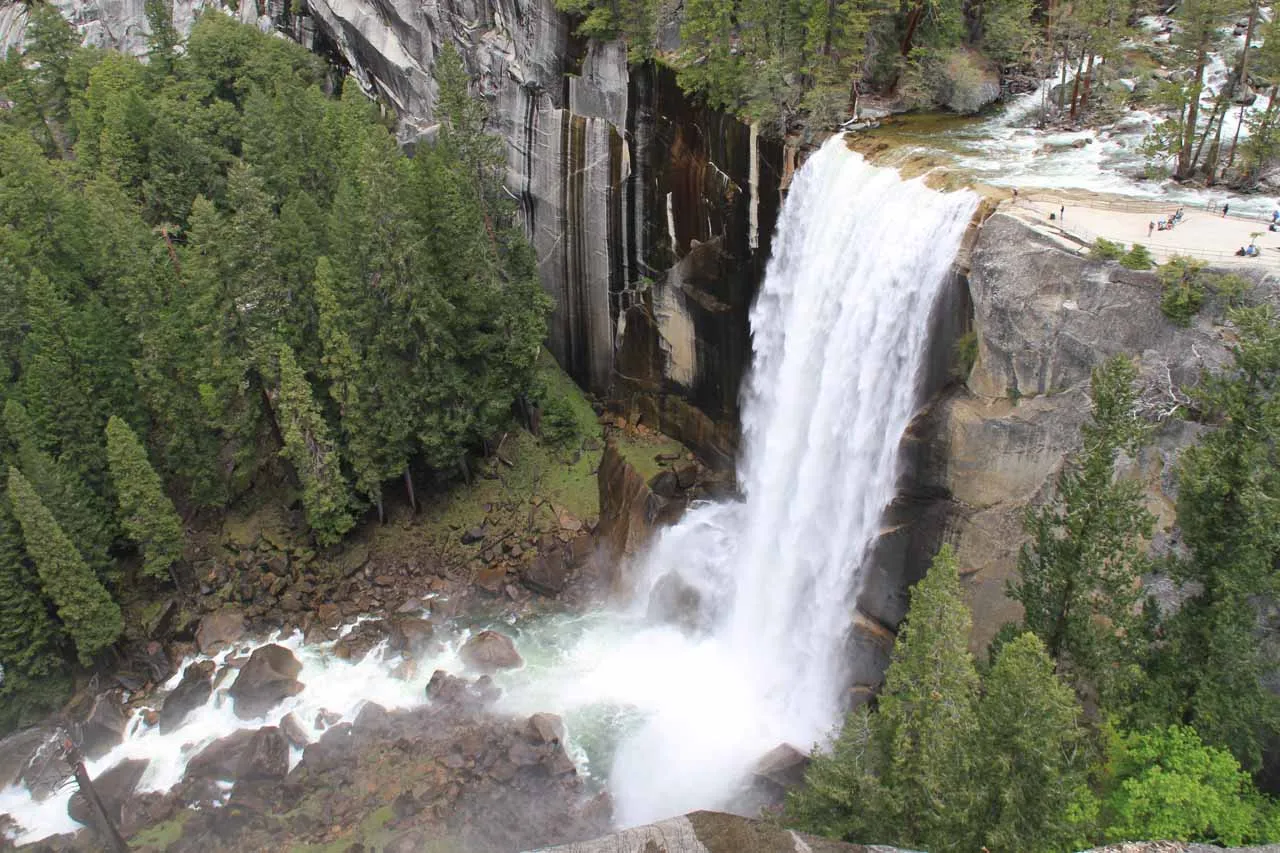
Nevada Fall
- Height: 594 feet (181 meters)
- Region: Mist Trail
- Flow: Seasonal, most powerful in spring
Nevada Fall is a majestic Yosemite National Park waterfall located above Vernal Fall on the Mist Trail. At 594 feet, it is higher than Vernal Fall and equally spectacular. The flow is strongest during the spring runoff, and the views from the top of the waterfall are breathtaking, offering expansive views of Yosemite Valley and surrounding peaks.
The Mist Trail continues beyond Vernal Fall and takes hikers up to Nevada Fall. This portion of the hike is steeper and more strenuous, with a series of switchbacks and narrow paths. For those with the stamina, hiking to Nevada Fall is an unforgettable experience, providing a front-row seat to one of the park’s most beautiful waterfalls.

Horsetail Fall & Firefall
- Height: 1,570 feet (478 meters)
- Region: Yosemite Valley
- Flow: Seasonal (often during late winter and early spring)
One of the most photogenic Yosemite National Park waterfalls, Horsetail Fall is known for its stunning appearance during the winter months. In February, this waterfall takes on a unique characteristic called the Firefall phenomenon, when the setting sun illuminates the waterfall in a vibrant orange-red glow. This phenomenon occurs only during a few days of the year and attracts photographers and visitors from all over the world.
The waterfall itself drops from a height of 1,570 feet, creating a dramatic stream of water flowing down the granite cliffs. The best time to view Horsetail Fall is in late February, when the Firefall effect occurs, but the waterfall is visible year-round, with the flow depending on snowmelt and rainfall.
>> Read More: Best Time To Visit Yosemite National Park: When is Good Time?

Silver Strand Falls
- Height: 500 feet (152 meters)
- Region: Yosemite Creek
- Flow: Seasonal, peak in spring
Located in a quieter area of Yosemite, Silver Strand Falls is often overlooked but offers a peaceful retreat for those who seek solitude. The Yosemite National Park waterfall drops 500 feet from the cliffs above and creates a serene, elegant cascade. Its location near Yosemite Creek makes it a great spot to visit during the spring months when the flow is at its strongest.
Though it’s less visited compared to other famous Yosemite waterfalls, Silver Strand Falls provides a stunning contrast to the more popular sites. The hike to the waterfall is moderate and requires a bit of off-trail navigation, so be prepared for a more rugged experience.

Ribbon Fall
- Height: 1,612 feet (491 meters)
- Region: Yosemite Valley
- Flow: Seasonal, peak in spring
Ribbon Fall is a hidden gem in Yosemite, standing at a dramatic 1,612 feet and known for its long, thin stream of water that cascades down the cliffs of Yosemite Valley. This Yosemite National Park waterfall is considered one of the tallest single-drop waterfalls in North America. Ribbon Fall is often overshadowed by the park’s larger waterfalls but is a stunning sight, especially when the snowmelt is strong in early spring.
The trail to Ribbon Fall is short and accessible, but it is not as well-known as other paths in Yosemite Valley, making it a quieter option for those looking to escape the crowds. The fall is usually dry by summer, so spring is the best time to visit.
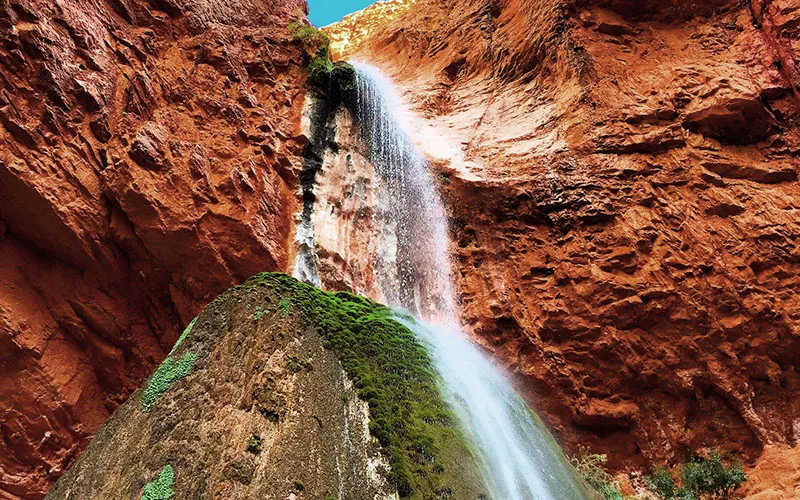
Chilnualna Falls
- Height: 2,400 feet (732 meters)
- Region: Wawona
- Flow: Seasonal, peak in spring
Chilnualna Falls is a hidden treasure in the Wawona area of Yosemite, offering a series of cascading waterfalls that drop a total of 2,400 feet. This multi-tiered Yosemite National Park waterfall is particularly impressive in the spring when the snowmelt increases the flow, creating a dramatic series of waterfalls. The hike to Chilnualna Falls is moderately strenuous and offers a less crowded alternative to the more popular trails in Yosemite Valley.
The hike itself provides several beautiful viewpoints, and you can choose to visit the lower or upper falls depending on how much time you have and your desired level of adventure. This trail is perfect for hikers looking for a more challenging experience combined with incredible views.
>> Read More: Top 15 Things To Do in Yosemite: Unique Things You Don't Know

Wapama Fall
- Height: 1,000 feet (305 meters)
- Region: Hetch Hetchy
- Flow: Seasonal, peak in spring
Wapama Fall is one of the largest and most breathtaking waterfalls in the Hetch Hetchy area of Yosemite National Park, with an impressive drop of 1,000 feet. The waterfall’s cascade is especially powerful in the spring, when snowmelt from the Sierra Nevada peaks feeds the flow, creating a stunning sight of rushing water down the rocky cliffs. As one of the lesser-known Yosemite National Park waterfalls, Wapama Fall offers a peaceful escape from the crowds that typically gather in Yosemite Valley. It’s a must-see for those who appreciate the beauty of Yosemite’s more serene, remote locations.
The Wapama Fall Trail is a 5-mile round-trip hike, which is moderate in difficulty, making it accessible to most hikers who are in good physical condition. The trail begins at the Hetch Hetchy Reservoir and meanders along the reservoir’s shoreline, offering panoramic views of the water and surrounding valley. Along the way, you’ll pass through oak and pine forests and enjoy a quiet atmosphere that’s perfect for those seeking solitude in nature. The trail has some gradual elevation gain, but it’s not as strenuous as other Yosemite hikes, making it ideal for families or those new to hiking.
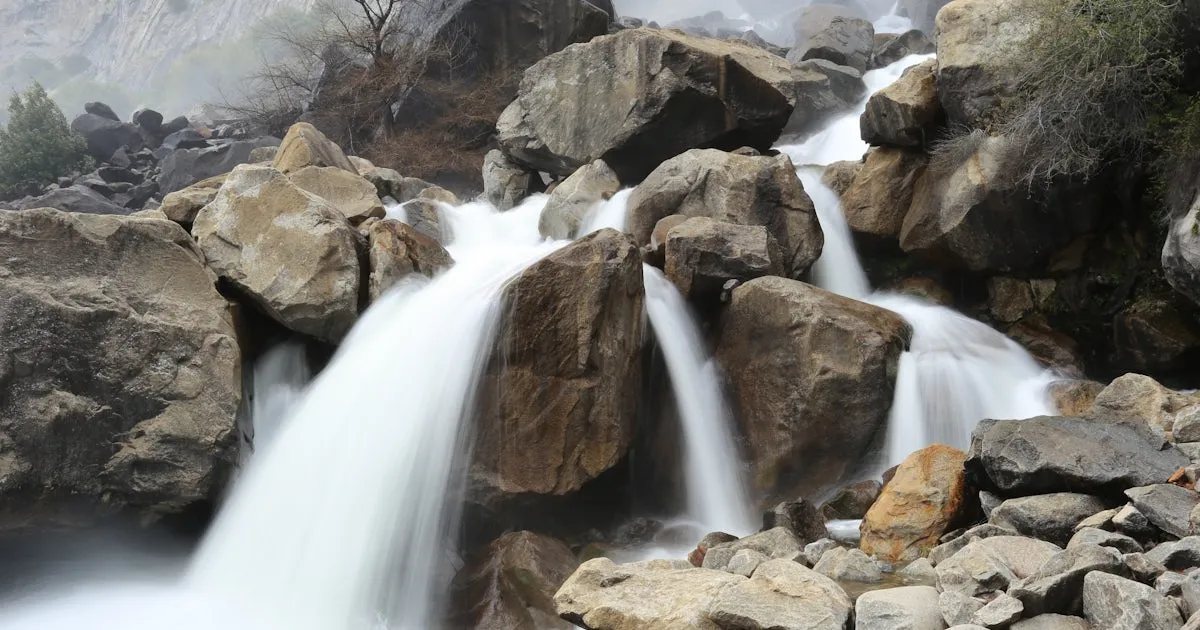
Sentinel Fall
- Height: 2,000 feet (610 meters)
- Region: Yosemite Valley
- Flow: Seasonal, peak in spring
Sentinel Fall is a majestic Yosemite National Park waterfall located on the western side of Yosemite Valley. At 2,000 feet, it’s one of the tallest waterfalls in Yosemite, and it offers a stunning view from several points within the valley. Sentinel Fall is typically at its most dramatic during the spring, when snowmelt increases its flow, sending a torrent of water rushing down the granite cliffs. During this time, the waterfall’s power and beauty are truly awe-inspiring, making it a must-see for visitors.
Unlike the crowded Yosemite Falls, Sentinel Fall is often quieter and more peaceful, providing a serene escape for those exploring Yosemite Valley. The Sentinel Fall Trail, which is a relatively short and easy hike, brings you to a great vantage point from where you can capture the waterfall in all its glory. It’s the perfect spot for photographers looking for a unique perspective of Yosemite’s famous granite cliffs and valleys.
The fall’s waters pour over the rocky ledges, creating a fine mist that often leads to vibrant rainbows when the sunlight hits just right. This Yosemite National Park waterfall is particularly stunning when viewed at sunrise or sunset, as the low light enhances the golden hues of the surrounding granite walls. Sentinel Fall is an excellent choice for those looking to experience the beauty of Yosemite’s waterfalls without venturing too far from the main valley.
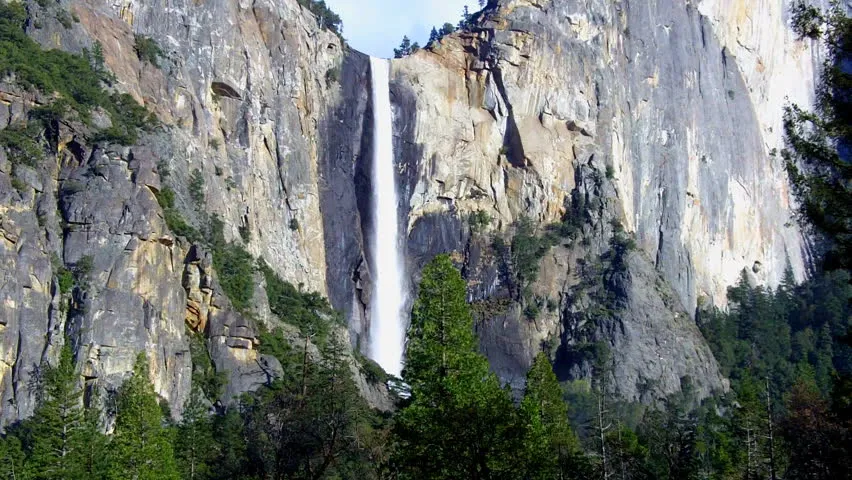
Upper Yosemite Falls
- Height: 1,430 feet (4362 meters)
- Region: Yosemite Valley
- Flow: Seasonal, peak in spring
Upper Yosemite Falls, with its 1,430-foot drop, is one of the most iconic and impressive Yosemite National Park waterfalls. It is the upper section of the famous Yosemite Falls, which together make up the tallest waterfall in North America. The upper portion itself is a spectacular sight, especially during the spring months when the snowmelt brings an abundant flow of water cascading down the cliff face. The sheer drop and the thunderous sound of the waterfall make Upper Yosemite Falls one of the most popular destinations in Yosemite National Park.
Hiking to the top of Upper Yosemite Falls is an exhilarating challenge that takes you up steep switchbacks, offering stunning views of the valley below. The Upper Yosemite Falls Trail is about 7.6 miles round-trip with a challenging elevation gain of 2,700 feet. For those who are up for the physical challenge, the trail provides incredible views of Yosemite Valley, El Capitan, Half Dome, and the surrounding wilderness. It’s a physically demanding hike, but the payoff is well worth the effort.
For those not interested in the steep climb, the Lower Yosemite Falls Trail provides an easier, short walk to the base of the waterfall, where you can enjoy a close-up view of the cascading water. No matter how you choose to experience Upper Yosemite Falls, it remains one of the most breathtaking waterfalls in the park, with its majestic beauty and immense size.
>> Read More: Visiting Yosemite National Park in November: Weather and More
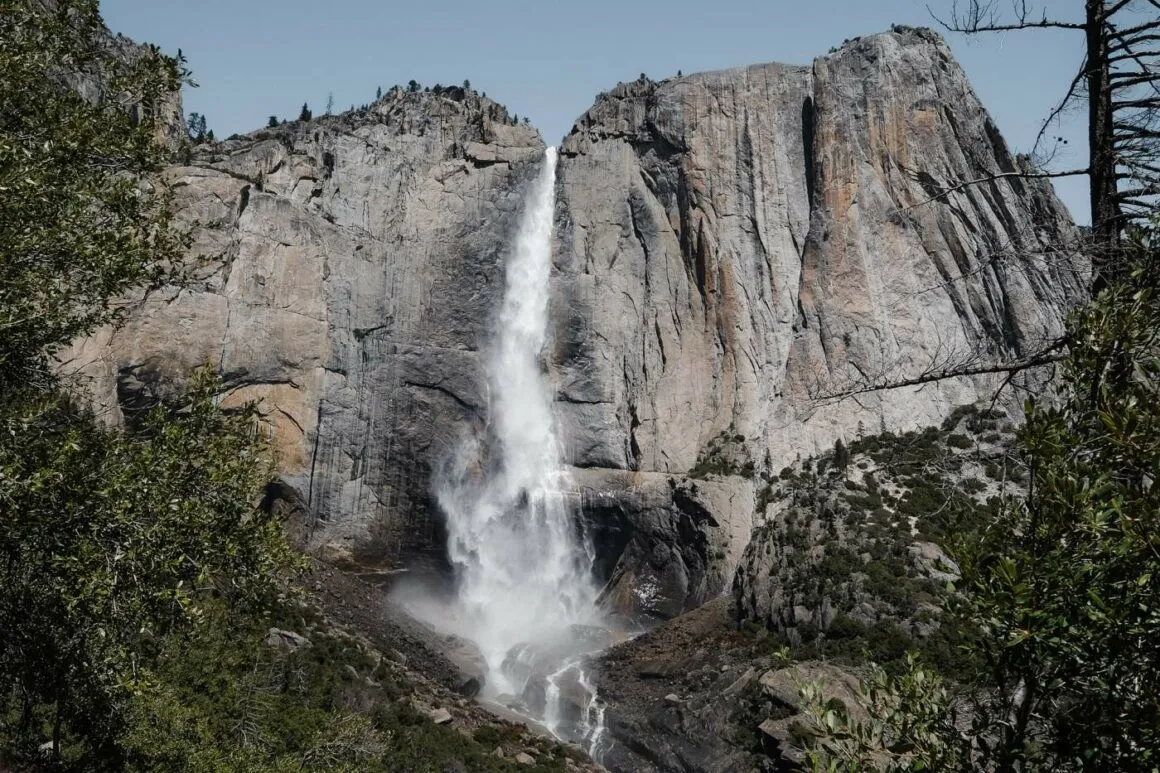
Lower Yosemite Falls
- Height: 320 feet (98 meters)
- Region: Yosemite Valley
- Flow: Seasonal, peak in spring
Lower Yosemite Falls is the lower section of Yosemite Falls, standing at 320 feet in height. Despite being smaller than its upper counterpart, Lower Yosemite Falls is still an impressive sight, especially in spring when it flows at its fullest. The base of the waterfall is easily accessible via the Lower Yosemite Falls Trail, which is a short, 0.5-mile loop that’s perfect for visitors who want to experience the majesty of the falls without committing to a lengthy hike.
One of the most popular times to visit Lower Yosemite Falls is during the spring snowmelt, when the Yosemite National Park waterfall is at its peak flow, creating a powerful cascade that crashes down into the pool below. The mist from the waterfall often creates rainbows on sunny days, offering fantastic photo opportunities. This short trail is perfect for families, photographers, and those who want a quick but beautiful experience of Yosemite’s iconic landscape.
Lower Yosemite Falls also serves as an excellent spot for resting after a long day of hiking in Yosemite Valley. The trail is paved, making it wheelchair and stroller accessible, which makes it a great option for all types of visitors. If you’re looking for a beautiful, peaceful spot to relax and enjoy the power of Yosemite National Park waterfalls, Lower Yosemite Falls is a must-see.
>> Read More: Yosemite National Park Giant Trees: Facts about Giant Sequoias
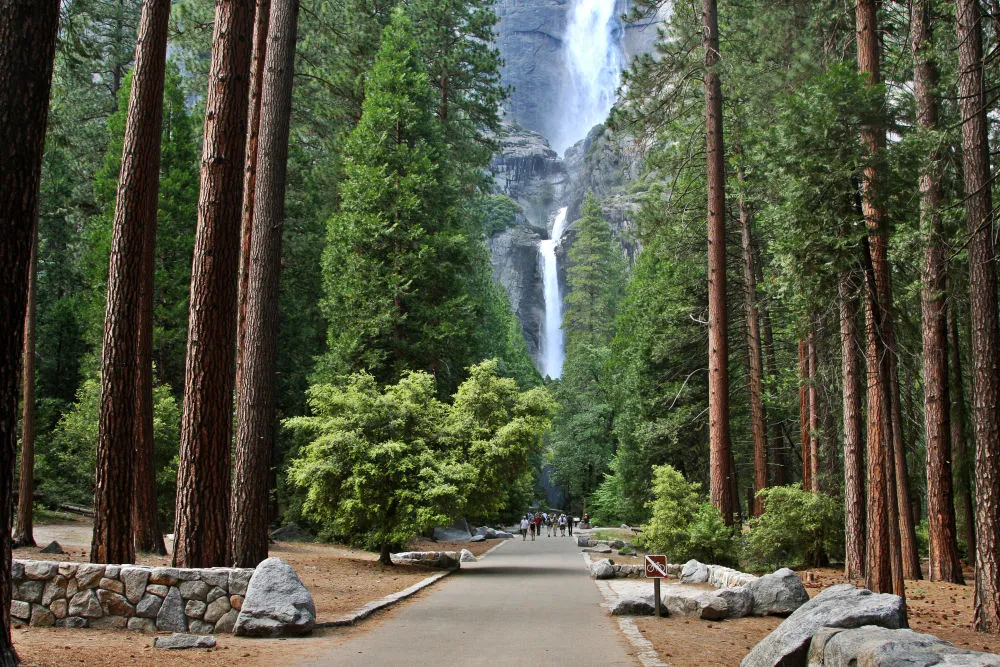
What to bring to hike the best waterfalls at Yosemite National Park
Before you embark on your adventure to see the stunning Yosemite National Park waterfalls, it’s important to be fully prepared. Here’s a handy list of essential items you should bring to ensure you’re ready for a safe and enjoyable hike.
Clothing & Gear
- Moisture-Wicking Clothes: Wear synthetic or merino wool layers to stay dry and warm.
- Waterproof Jacket: A breathable rain jacket is essential to protect you from mist and rain.
- Comfortable Hiking Pants: Opt for convertible pants to adjust to changing weather.
- Sturdy Footwear: Wear well-fitting hiking boots or trail shoes with good traction.
- Hat & Sunglasses: Protect your eyes and face from the sun, especially near the water.
Hydration & Snacks
- Water: Bring at least 3 liters of water to stay hydrated.
- Snacks: Pack high-energy foods like trail mix, energy bars, or fruit to keep your energy up.
Navigation & Safety
- Trail Map: Always carry a physical map, as there may be limited cell service.
- Headlamp: Bring a headlamp for visibility if you’re hiking in low light or staying out late.
- First Aid Kit: Pack essentials like band-aids, antiseptic, and any personal medications.
- Whistle: For emergencies, having a whistle can be helpful for signaling.
Other Essentials
- Sun Protection: Apply sunscreen and use SPF lip balm regularly.
- Bug Repellent: Keep mosquitoes away with some good bug repellent.
- Trash Bags: Carry bags to clean up after yourself and follow Leave No Trace principles.
- Plastic Poncho: A lightweight poncho will help you stay dry during unexpected rain or waterfall mist.
Conclusion
Yosemite National Park is home to some of the most beautiful and dramatic waterfalls in the world. Whether you’re looking to challenge yourself with a steep climb to Upper Yosemite Falls, or prefer a more accessible experience like visiting Bridalveil Fall, Yosemite’s waterfalls offer something for everyone. Plan your trip in spring for the best water flow, and be sure to bring your hiking gear to explore these breathtaking natural wonders. The Yosemite National Park waterfalls are an integral part of its magic and beauty, making them a must-see on any Yosemite adventure.
SAME TOPIC:

